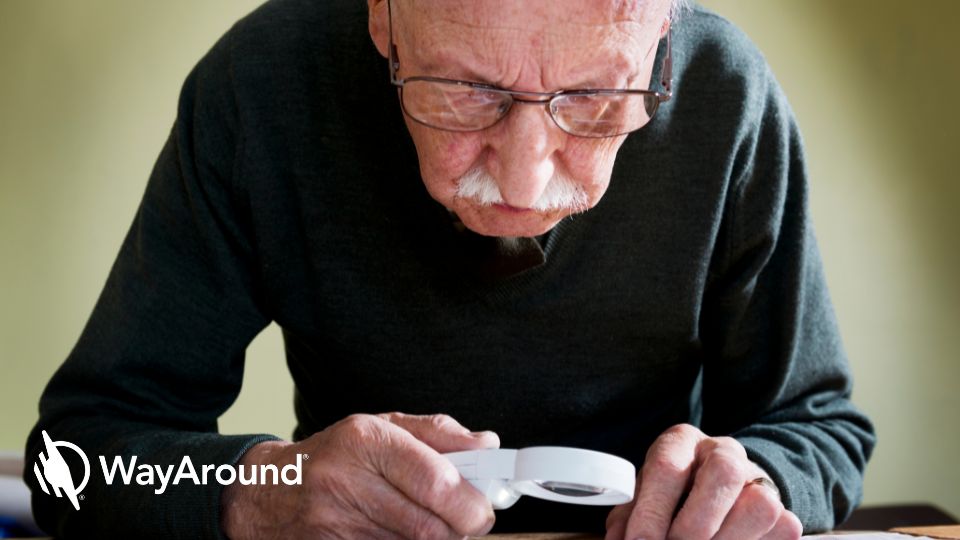Changing eyesight due to age or other factors affects millions of adults each year. Sometimes it can be corrected with glasses or contacts or even surgery. When someone has low vision that cannot be corrected, it can feel like you’re not just losing eyesight but also independence. At WayAround, we often hear from people who don’t want to be a burden to their friends or family by constantly asking, “What’s this?”
You don’t have to stop doing the things you love just because your eyesight isn’t great. Today, we’re sharing 10 tips for seniors (or anyone) with sight loss, so that you can regain confidence and independence.
1. Add task lighting.
Good lighting is one of the most important ways to maximize your useable vision. Task lighting in key areas will help make it easier to see when doing everyday tasks. There are lots of options to suit your needs and your style.
To help identify where to add lighting, think through your day. Is the lighting in your bathroom bright enough? If you just have an overhead light, can you add lighting nearer to your face to avoid shadows? In the kitchen and near a favorite chair are other excellent places to add task lighting.
2. Use contrast whenever possible.
High contrast makes it easier to distinguish between items and surfaces. Plan in layers for the best effect. If you have light-colored walls, go for darker sofas. Use light-colored throw pillows placed in each corner to help you identify where to sit.
You can use contrast in your kitchen when preparing food and also when setting the table.
3. Explore your phone’s accessibility settings.
Making good use of your smartphone’s accessibility features will keep you connected to all of the apps you rely on. Both Apple and Google have accessibility departments that release new features for people with sight loss, hearing loss, intellectual disabilities and more. You can adjust the font size, weight, contrast, and more. Many people also enjoy using the built-in screen reader: VoiceOver on iOS devices and TalkBack on Android. These services will read aloud text and you can navigate using gestures like swiping and tapping.
We highly recommend familiarizing yourself with your phone’s screen reader, even if you have a good amount of useable vision. It’s helpful if your eyes are feeling tired. And if your vision worsens, you will be a step ahead.
The Hadley Insititue has great trainings on using both TalkBack for Android and VoiceOver for iOS.
4. Label!
Labeling is one of the best ways you can increase your independence. Thinking about labeling everything can feel overwhelming, so take it one step at a time. Start labeling items that you often have to ask someone about. Once you’ve labeled something, it becomes permanently accessible.
There are lots of labeling systems to choose from. If you have a good amount of useable vision, you may be able to use a mailing label and sharpie to get the information you need. An electronic labeling system like WayAround will let you identify what an item is and also provide details like expiration dates and laundering instructions.
If you have a degenerative eye condition and you know that your eyesight will get worse, choose a system that can adapt as your vision changes. Anything that works with your smartphone should allow you to tailor it to your preferred accessibility settings.
5. Go big!
If you have some useable vision, reduce eye strain by finding large print items whenever possible. You can also have magnifiers on hand in areas where you may frequently need them: a nightstand, desk, or sofa table. There are lots of brick-and-mortar low vision stores that have examples of products you can purchase. Online retailers have extensive catalogs of low vision aids and magnifiers.
6. Everything in its place.
Organization and labeling go hand in hand. As you label items, you can ensure they are organized in a way that makes sense and you can maintain. Keeping your things in their place makes it easier to find them. And keeping surfaces tidy helps prevent spills and tripping.
7. Rely on audio.
If listening to something is easier than trying to see fine print, then seek out audio options. From audiobooks to talking gadgets, there are lots of options for daily living and entertainment that do not require any eyesight at all. Even digital assistants like Siri and Amazon Alexa can make life easier.
8. Get connected.
Adjusting to sight loss isn’t just about physical adjustments. There are social and emotional adjustments as well. There are lots of organizations that meet in-person or virtually where people with sight loss can connect with each other. Some of these are based geographically while others have themes like senior citizens or crafting. Check out the American Council of the Blind and the National Federation of the Blind to explore how you can get connected with others who have experienced sight loss. Making these connections can help you feel like you’re not alone.
9. Find training.
It may seem like there’s a learning curve for every little thing. Getting training can help you break these new experiences down into manageable steps. Most states have training centers that offer a variety of services. Programs offered through Workforce Development are geared toward helping people find work and stay employed. Centers for Independent Living offer daily living skills training for people who are retired or do not plan to work.
There are also terrific online resources like Hadley, which offer on-demand trainings on lots of topics–from computer skills to container gardening.
10. Remember, you can do this!
Losing eyesight is not easy. Patience and persistence coupled with good training will help you gain confidence and independence in doing the things you want to do.

